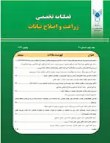Effects of biological fertilizers, super absorbent polymer, Humic acid on chlorophyll content, membrane lipid and superoxide dismutase and catalase activity in annual medic (Medicago scutellata) under cadmium toxicity
Author(s):
Abstract:
Some plant species have been the ability to resist environmental stress conditions, so with their mechanism were prevented further production of reactive oxigen species (ROS). The first step in implementing phytoremediation strategy is identifying plant species that are resistant to heavy metals and also to identify factors that increase the resistance of plants against heavy metal toxicity conditions for successful phytoremediation. Accordingly, to investigate the role of biological fertilizers, superabsorbent and humic acid on physiological characteristics of annual medics, an experiment was done in 2009 in factorial design as a completely randomized design (CRD) with four replications. The first factor was levels of Cadmium [0- 40 - 80 mg /kg soil cadmium chloride (CdCl2)] and the second factor included treatments (application of plant growth promoting rhizobacteria, mycorrhiza fungi, humic acid and superabsorbent polymer) separately and combined with 16 levels. Results showed in control treatment, total chlorophyll content and MDA under cadmium toxicity decreased. with increasing concentrations of cadmium activity of SOD (SOD) and catalase (CAT) increased.which were prevented further production of reactive oxigen species (ROS) in Medicago scutellata plant. The correlation between the capacity of malondialdehyde (MDA) and superoxide dismutase and catalase (CAT) activity were positive. This means that with increasing malondialdehyde (MDA) (SOD) and (CAT) activity increased.with increasing cadmium concentration chlorophyll a, b and a + b content decreased. This reduction was observed in the highest cadmium concentration (80 mg/kg soil CdCl2). In b2 [application plant growth promoting rhizobacteria (PGPR)] and b8 [application of plant growth promoting rhizobacteria (PGPR) + mycorrhiza fungi] treatments reduced synthesis of chlorophyll was lower than the control treatment.b5 [application super absorbent polymer + plant growth promoting rhizobacteria (PGPR)] and b9 [application Humic acid + plant growth promoting rhizobacteria (PGPR)] treatments had the lowest SOD and CAT activity. This could be due that plant growth promoting rhizobacteria through another mechanism, such as proline production, are coping with reactive oxigen species (ROS). Also in this treatments malondialdehyde content was lower than control treatment. This result indicates that with decreasing malondialdehyde (MDA), lipid peroxidation decreased and ROS production also decreases.
Keywords:
Language:
Persian
Published:
Journal of Agronomy and Plant Breeding, Volume:6 Issue: 2, 2010
Pages:
65 to 79
magiran.com/p1206767
دانلود و مطالعه متن این مقاله با یکی از روشهای زیر امکان پذیر است:
اشتراک شخصی
با عضویت و پرداخت آنلاین حق اشتراک یکساله به مبلغ 1,390,000ريال میتوانید 70 عنوان مطلب دانلود کنید!
اشتراک سازمانی
به کتابخانه دانشگاه یا محل کار خود پیشنهاد کنید تا اشتراک سازمانی این پایگاه را برای دسترسی نامحدود همه کاربران به متن مطالب تهیه نمایند!
توجه!
- حق عضویت دریافتی صرف حمایت از نشریات عضو و نگهداری، تکمیل و توسعه مگیران میشود.
- پرداخت حق اشتراک و دانلود مقالات اجازه بازنشر آن در سایر رسانههای چاپی و دیجیتال را به کاربر نمیدهد.
In order to view content subscription is required
Personal subscription
Subscribe magiran.com for 70 € euros via PayPal and download 70 articles during a year.
Organization subscription
Please contact us to subscribe your university or library for unlimited access!


